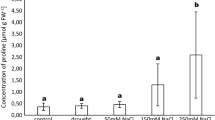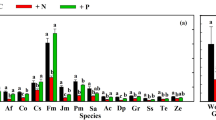Abstract
Arbuscular mycorrhizal (AM) colonization can strongly affect the plant cell nucleus, causing displacement from the periphery to the center of the cell, hypertrophy and polyploidization. The hypertrophy response has been shown in a variety of AM plants whilst polyploidization has been reported only in Lycopersicon esculentum, a multiploid species with a small genome. In order to determine whether polyploidization is a general plant response to AM colonization, analyses were performed on Allium porrum, a plant with a large genome, which is much less subject to polyploidization than L. esculentum. The ploidy status of leaves, complete root systems and four zones of the adventitious roots was investigated in relation to phosphorus content, AM colonization and root differentiation in A. porrum plants grown under two different regimes of phosphate nutrition in order to distinguish direct effects of the fungus from those of improved nutrition. Results showed the presence of two nuclear populations (2C and 4C) in all treatments and samples. Linear regression analyses suggested a general negative correlation between phosphorus content and the proportion of 2C nuclei. The percentage of 2C nuclei (and consequently that of 4C nuclei), was also influenced by AM colonization, differentiation and ageing of the root cells, which resulted in earlier occurrence, in time and space, of polyploid nuclei.




Similar content being viewed by others
References
Amijee F, Tinker PB, Stribley DP (1989) The development of endomycorrhizal root systems. VII. A detailed study of effects of soil phosphorus on colonization. New Phytol 111:435–446
Balestrini R, Berta G, Bonfante P (1992) The plant nucleus in mycorrhizal roots: positional and structural modifications. Biol Cell 75:235–243
Baluska F, Bacigálová K, Oud JL, Hauskrecht M, Kubica S (1995) Rapid reorganization of microtubular cytoskeleton accompanies early changes in nuclear ploidy and chromatin structure in postmitotic cells of barley leaves infected with powdery mildew. Protoplasma 185:140–151
Baluska F, Samaj J, Volkmann D, Barlow PW (1997) Impact of taxol-mediated stabilization of microtubules on nuclear morphology, ploidy level and cell growth in maize roots. Biol Cell 89:221–231
Barea JM, Azcon-Aguilar C (1982) Production of plant growth regulating substances by the vesicular-arbuscular mycorrhizal fungus Glomus mosseae. Appl Environ Microbiol 43:810–813
Barker SJ, Tagu D (2000) The roles of auxins and cytokinins in mycorrhizal symbioses. J Plant Growth Regul 19:144–154
Bennett MD, Leitch IJ (1995) Nuclear DNA amounts in Angiosperms. Ann Bot 76:113–176
Berta G, Fusconi A (1998) Effects of arbuscular mycorrhizal and ericoid fungi on the structure and activity of host cell nuclei. In: Bryant J, Chiatante D (eds) Plant cell proliferation and its regulation in growth and development. Wiley, Chichester, pp 135–151
Berta G, Sgorbati S, Soler V, Fusconi A, Trotta A, Citterio A, Bottone MG, Sparvoli E, Scannerini S (1990a) Variations in chromatin structure in host nuclei of a vesicular arbuscular mycorrhiza. New Phytol 114:199–205
Berta G, Fusconi A, Trotta A, Scannerini S (1990b) Morphogenetic modifications induced by the mycorrhizal fungus Glomus strain E3 in the root system of Allium porrum L. New Phytol 114:207–215
Berta G, Fusconi A, Lingua G, Trotta A, Sgorbati S (1996) Influence of arbuscular mycorrhizal infection on nuclear structure and activity during root morphogenesis. In: Azcon-Aguilar C, Barea JM (eds) Mycorrhizas in integrated systems from genes to plant development. Proceedings of the fourth European Symposium on Mycorrhizas, Granada, Spain, 11–14 July 1994. European Commission, Brussels, pp 174–177
Berta G, Fusconi A, Sampò S, Lingua G, Repetto O (2000) Polyploidy and respiratory activity in AM colonised tomato roots. Plant Soil 226:37–44
Blancaflor EB, Zhao L, Harrison MJ (2001) Microtubule organization in root cells of Medicago truncatula during development of an arbuscular mycorrhizal symbiosis with Glomus versiforme. Protoplasma 217:154–165
Brewster JL (1994) Onions and other vegetable alliums. CAB International, Wallingford
Cebolla A, Vinardell JM, Kiss E, Oláh B, Roudier F, Kondorosi A, Kondorosi E (1999) The mitotic inhibitor ccs52 is required for endoreduplication and ploidy-dependent cell enlargement in plants. EMBO J 18:4476–4484
Chiou TJ, Liu H, Harrison MJ (2001) The spatial expression patterns of a phosphate transporter (MtPT1) from Medicago truncatula indicate a role in phosphate transport at the root/soil interface. Plant J 25:281–293
Cox G, Tinker PB (1976) Translocation and transfer of nutrients in vesicular-arbuscular mycorrhizas. I. The arbuscule and phosphorus transfer: a quantitative ultrastructural study. New Phytol 77:371–378
D’Amato F (1998) Chromosome endoreduplication in plant tissue: development and function. In: Bryant JA, Chiatante D (eds) Plant cell proliferation and its regulation in growth and development. Wiley, Chichester, pp 153–166
Danneberg G, Latus C, Zimmer W, Hundeshagen B, Schneider-Poetsch H, Bothe H (1992) Influence of vesicular-arbuscular mycorrhiza on phytohormone balance in maize (Zea mays L.). J Plant Physiol 141:33–39
Esch H, Hundeshagen B, Schneider-Poetsch H, Bothe H (1994) Demonstration of abscisic acid in spores and hyphae of the arbuscular-mycorrhizal fungus Glomus and the N2-fixing cyanobacterium Anabaena variabilis. Plant Sci 99:9–16
Fries LLM, Pacovsky RS, Safir GR (1998) Phosphorus effect on phosphatase activity in endomycorrhizal maize. Physiol Plant 103:162–171
Fusconi A, Tagliasacchi AM, Berta G, Trotta A, Brazzaventre S, Ruberti F, Scannerini S (2000) Root apical meristems of Allium porrum L. as affected by arbuscular mycorrhizae and phosphorus. Protoplasma 214:219–226
Galbraith DW, Harkins KR, Knapp S (1991) Systemic endopolyploidy in Arabidopsis thaliana. Plant Physiol 96:985–989
Galitski T, Saldanha AJ, Styles CA, Lander ES, Fink GR (1999) Ploidy regulation of gene expression. Science 285:251–254
Gendreau E, Orbovic V, Höfte H, Traas J (1999) Gibberellin and ethylene control endoreduplication levels in the Arabidopsis thaliana hypocotyl. Planta 209:513–516
Genre A, Bonfante P (1998) Actin versus tubulin configuration in arbuscule-containing cells from mycorrhizal tobacco roots. New Phytol 140:745–752
Gianinazzi-Pearson V (1996) Plant cell response to arbuscular mycorrhizal fungi: getting to the roots of the symbiosis. Plant Cell 8:1871–1883
Gutierrez C, Ramirez-Parra E, Castellano MM, del Pozo JC (2002) G1 to S transition: more than a cell cycle engine switch. Curr Opin Plant Biol 5:480–486
Kondorosi E, Kondorosi A (2004) Endoreduplication and activation of the anaphase-promoting complex during symbiotic cell development. FEBS Lett 567:152–157
Kondorosi E, Roudier F, Gendreau E (2000) Plant cell-size control: growing by ploidy? Curr Opin Plant Biol 3:488–492
Kosuta S, Chabaud M, Luognon G, Gough C, Dénarié J, Barker DG, Bécard G (2003) A diffusible factor from arbuscular mycorrhizal fungi induces symbiosis-specific MtENOD11 expression in roots of Medicago truncatula. Plant Physiol 131:952–962
Kudo N, Kimura Y (2001) Patterns of endopolyploidy during seedling development in cabbage (Brassica oleracea L.). Ann Bot 87:275–281
Kudo N, Kimura Y (2002) Nuclear DNA endoreduplication during petal development in cabbage: relationship between ploidy levels and cell size. J Exp Bot 53:1017–1023
Larkins BA, Dilkes BP, Dante RA, Coelho CM, Woo YM, Liu Y (2001) Investigating the how and why of DNA endoreduplication. J Exp Bot 52:183–192
Liu C, Muchhal US, Uthappa M, Kononowicz AK, Raghothama KG (1998a) Tomato phosphate transporter genes are differentially regulated in plant tissues by phosphorus. Plant Physiol 116:91–99
Liu H, Trieu AT, Blaylock LA, Harrison MJ (1998b) Cloning and characterization of two phosphate transporters from Medicago truncatula roots: regulation in response to phosphate and to colonization by arbuscular mycorrhizal (AM) fungi. Mol Plant Microbe Interact 11:14–22
Martin C, Bhatt K, Baumann K (2001) Shaping in plant cells. Curr Opin Plant Biol 4:540–549
Melaragno JE, Mehrotra B, Coleman AW (1993) Relationship between endopolyploidy and cell size in epidermal tissue of Arabidopsis. Plant Cell 5:1661–1668
Mittelsten Scheid O, Jacovleva L, Afsar K, Maluszynska J, Paszkowski J (1996) A change in ploidy can modify epigenetic silencing. Proc Natl Acad Sci USA 93:7114–7119
Mizukami Y (2001) A matter of size: developmental control of organ size in plant. Curr Opin Plant Biol 4:533–539
Müller ML, Barlow PW, Pilet PE (1994) Effect of abscisic acid on the cell cycle in the growing maize root. Planta 195:10–16
Rosewarne GM, Barker SJ, Smith SE, Smith FA, Schachtman DP (1999) A Lycopersicon esculentum phosphate transporter (LePT1) involved in phosphorus uptake from a vesicular-arbuscular mycorrhizal fungus. New Phytol 144:507–516
Shaul-Keinan O, Gadkal V, Ginzberg I, Grunzweig JM, Chet I, Elad Y, Wininger S, Belausov E, Eshed Y, Arzmon N, Ben-Tal Y, Kapulnik Y (2002) Hormone concentrations in tobacco roots change during arbuscular mycorrhizal colonization with Glomus intraradices. New Phytol 154:501–507
Smith SE, Smith FA, Jakobsen I (2003) Mycorrhizal fungi can dominate phosphate supply to plants irrespective of growth responses. Plant Physiol 133:16–20
Tisserant B, Gianinazzi-Pearson V, Gianinazzi S, Gollotte A (1993) In planta histochemical staining of fungal alkaline phosphatase activity for analysis of efficient arbuscular mycorrhizal infection. Mycol Res 97:245–250
Torelli A, Trotta A, Acerbi L, Arcidiacono G, Berta G, Branca C (2000) IAA and ZR content in leek (Allium porrum L.), as influenced by P nutrition and arbuscular mycorrhizae, in relation to plant development. Plant Soil 226:29–35
Trotta A, Carminati C, Schellenbaum L, Scannerini S, Fusconi A, Berta G (1991) Correlation between root morphogenesis, VA mycorrhizal infection and phosphorus nutrition. In: McMichael BL, Persson H (eds) Plant roots and their environment. Elsevier, Amsterdam, pp 333–339
Trouvelot A, Kough JL, Gianinazzi-Pearson V (1986) Mesure du taux de mycorhization VA d’un systéme radiculaire. Recherche de méthodes d’estimation ayant une signification fonctionelle. In: Gianinazzi-Pearson V, Gianinazzi S (eds) Physiological and genetical aspects of mycorrhizae. Proceedings of the 1st European Symposium on Mycorrhizae. CNRS-INRA, Dijon, pp 217–222
Valente P, Tao W, Verbelen J-P (1998) Auxins and cytokinins control DNA endoreduplication and deduplication in single cells of tobacco. Plant Sci 134:207–215
Wolffe AP (1991) Implication of DNA replication for eukaryotic gene expression. J Cell Sci 99:201–206
Acknowledgements
This paper has been supported by Italian MURST.
Author information
Authors and Affiliations
Corresponding author
Rights and permissions
About this article
Cite this article
Fusconi, A., Lingua, G., Trotta, A. et al. Effects of arbuscular mycorrhizal colonization and phosphorus application on nuclear ploidy in Allium porrum plants. Mycorrhiza 15, 313–321 (2005). https://doi.org/10.1007/s00572-004-0338-x
Received:
Accepted:
Published:
Issue Date:
DOI: https://doi.org/10.1007/s00572-004-0338-x




